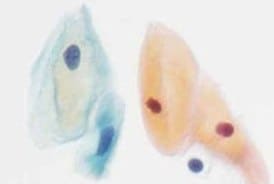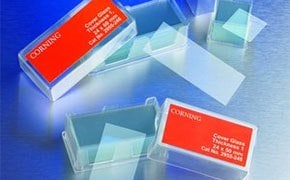Cytology & Cytodiagnosis

Cytology is the study of the structure and function of cells, while cytodiagnosis is the use of cytology as a diagnostic tool. Cytodiagnosis relies on well-established, highly specific stains and protocols to facilitate the identification of abnormalities in cells with microscopy. In human cytodiagnosis, there are two areas of cytology (gynecological and non-gynecological) in which specimens are examined for the presence of malignant and premalignant cells.
Featured Categories
We offer a complete selection of microscopy reagents, tools, and glassware for research and clinical lab analysis from Corning®, BRAND®, PELCO®, and other reliable specialty brands.
Accurate, consistent cell counting is critical for cell culture and downstream cellular assays and experiments. A handheld coulter counter provides the most accurate and reproducible cell counts in seconds. Disposable hemocytometers reduce risk in infectious settings.
Cytologic Sampling
In cytodiagnosis, the cells are extracted from the tissue mass, or sample fluid and are transferred to a cytological slide, stained, examined, and evaluated. The architecture of the original tissue becomes unrecognizable, and cannot aid in the evaluation process. Specimen materials such as sputum, urine, body cavity effusions, and lavage material are centrifuged, and the sediment is subsequently smeared onto a microscope slide. Image-assisted or simple fine‑needle aspiration biopsy (FNAB) material from the breast, thyroid, lymph nodes, prostate, cerebrospinal fluid, and other locations are carefully smeared onto slides. Depending on the staining method, the smeared samples are either fixed immediately (Papanicolaou’s stain) or thoroughly dried in air prior to hematological or any other staining.

Fixation for Cytology
A precondition for exact cytological diagnosis is the perfect fixation of sample material. Specimens must be fixed immediately after collection to prevent cells from drying out and shrinking. Immediate fixing retains the specimen’s structural features for clear staining and differentiation. Staining artifacts can interfere with diagnosis if specimens are fixed too late. The classic method of fixing is to immerse the microscope slide in 96% ethanol for 30 minutes. A more efficient way is to fix cells with a spray fixative. Spray fixatives are aqueous-alcoholic solutions containing polyethylene glycol (PEG). They are suitable for all types of cytological materials stained by the Papanicolaou method.
Cytodiagnosis Staining Methods
The choice of stain largely depends both on specimen origin and the experience and preference of the investigator. For instance, Papanicolaou’s staining technique is not only used for gynecological smears, like PAP smears, but also is routinely used for non-gynecological material, such as sputum, cerebrospinal fluid, synovial fluid, and urine. Giemsa’s stain is widely used for FNAB specimens from lymph nodes. Pappenheim’s stain is used for urinary sediments, effusions, bronchial lavage material, and FNAB material from various locations (e.g., breast, thyroid, cerebrospinal fluid). Wright’s stain is a hematological stain which can be used for differentiating blood cell types. Stained cells are prepared for microscopy using standard alcohol/xylene dehydration, clearing, and mounting. In addition to manual staining methods, mechanical and automated staining systems can be used to prepare large numbers of samples. A fully automated evaluation system can then be used for screening, wherein stained samples are evaluated, abnormal cells or groups of cells are marked, and images are saved in a gallery for retrieval and further investigation.
Cytodiagnostic Interpretation
Microscopic examination of the material can be performed immediately depending on the fixation, preparation, and staining techniques employed. This feature makes cytodiagnosis suitable for large volume screenings, such as cervical screenings. One critical point in cytodiagnosis is that the results of cytological investigations relate directly to the location from which the specimen was collected. For the sake of efficiency, sampling and preparation techniques must be thoroughly mastered and controlled. Suitable controls should be used with each application to avoid an incorrect result.
The success and efficiency of diagnostic cytology are measured by its ability to detect the early changes in disease state (sensitivity) while simultaneously preventing false-positive diagnoses (specificity). The sensitivity and specificity rely on proper sample collection, fixation, staining, and interpretation. Alongside imaging techniques such as x-ray imaging, computed tomography (CT), ultrasound, nuclear spin tomography, and positron emission tomography (PET); cytology is an indispensable part of the diagnosis.
Visit our document search for data sheets, certificates and technical documentation.
Related Articles
- Study tumor metastasis via various migration and invasion assays like Boyden chamber assay, Millicell® µ-Migration Assay, and scratch assay.
- Cellular apoptosis assays to detect programmed cell death using Annexin V, Caspase and TUNEL DNA fragmentation assays.
- For good cell attachment the hydrophobic polystyrene surface must be modified to a more hydrophilic surface. This allows cell attachment proteins (vitronectin and fibronectin) found in the serum containing culture medium to adhere and spread on the vessel bottom providing a better surface for cells to attach
- For microbiologists the most fundamental stain was developed in 1884 by the Danish bacteriologist Hans Christian Gram.
- Overview of primary cells and media usage in biomedical culture applications highlights differences from cell lines.
- See All (8)
Related Protocols
- Assay protocol for the colorimetric detection of Hydroxyproline in biological samples using the Hydroxypoline assay kit.
- Trypsin is commonly used for dissociating adherent cells from surfaces. A wide variety of trypsin solutions are available to meet your specific cell line requirements.
- To prepare a Percoll gradient, the osmolality of Percoll must be adjusted with saline or cell culture medium to make Percoll isotonic with physiological salt solutions.
- Cell culture protocol for passaging and splitting adherent cell lines using trypsin EDTA. Free ECACC handbook download.
- See All (6)
Find More Articles and Protocols
How Can We Help
In case of any questions, please submit a customer support request
or talk to our customer service team:
Email custserv@sial.com
or call +1 (800) 244-1173
Additional Support
- Calculators & Apps
Web Toolbox - science research tools and resources for analytical chemistry, life science, chemical synthesis and materials science.
- Customer Support Request
Customer support including help with orders, products, accounts, and website technical issues.
- FAQ
Explore our Frequently Asked Questions for answers to commonly asked questions about our products and services.
To continue reading please sign in or create an account.
Don't Have An Account?

